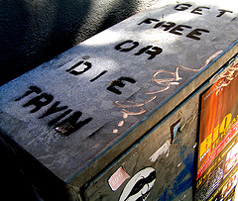One of the blogs I enjoy reading is that of Chandler Branch, who is the Executive Director of the non-profit organization Soli Deo Gloria. Chandler is not a frequent blogger, but is a thoughtful, and generally thought-provoking writer, generally about issues germain to non-profit arts organizations, and SDG specifically.
- shameless plug for an organization I believe does a great job: Soli Deo Gloria derives its name from the practice of composer Johann Sebastian Bach, who inscribed many of his compositions with the Latin phrase, SOLI DEO GLORIA (to God alone be the Glory). Since its establishment as a nonprofit organization in 1993, Soli Deo Gloria has sought to facilitate the creation of sacred classical music, at the highest level, to the glory of God. To this end, Soli Deo Gloria has channeled the support of its donors in three unique directions: (1) sponsorship of sacred music concerts around the world, (2) sponsorship of recordings of sacred music, and (3) commissions for new sacred music from the world’s leading composers.
In a recent blog post entitled Arts and the Future, Chandler made a number of important observations:
The cultural real estate the arts will claim in the future is difficult to surmise. Among a myriad of variables in play [are] the economic instability, social diversity and media saturation [which] make it nearly impossible to know how art will thrive…as the 21st century further unfolds. The dynamics of private and public patronage…are in flux. Social media and the race for the virtual fan base command an almost era-defining significance while their ultimate value remains largely unknown. Old audiences are receding. New audiences are coming of age… whose interest in art will not be won by tomorrow’s development initiatives as much as by today’s primary and secondary education programs. Board and executive leadership in the arts will soon completely pass from the hands of Baby Boomers to those of generations hardly capable of recalling a world without digital communication and media platforms that revolutionized the flow of information over the last two decades. Will broad interest in art be sustained in an increasingly…competitive era? Will funding increase in concert with rising production costs? How will arts organizations weather recession, war and crises yet to come?
Change the word “art” to “church” and read that paragraph again. Better yet, change it to “arts in the church.”
Branch lists two critical attributes to ensure not just the survival but the prospering of arts organizations: Adaptation and Innovation, and Going Beyond Relevance. Let’s look at how arts organizations are going beyond relevance, and how that is relevant to the arts in the church.
Citing a very specific campaign mounted in the face of the risk of losing the Salt Lake City Symphony, Branch highlights three important reasons the community needed the arts organization: Civic Pride, Educational Value, and Economic Importance.
This has certainly been my experience during the course of my ministry. When the music/worship ministry is a source of pride (and I’m not going to address all the “prideful” arguments here…I trust the reader understands what I mean) in the hearts, minds, and worship experiences of a congregation; when it serves as an educational mission, not just a performance diversion; and when it serves as, and is supported as an important part of the “total package” of the church’s mission and ministry to the community in which it resides, the arts “plus” the church in all three areas.
Specifically, I have seen a commitment to excellence in a children’s music program grow the church in attendance, giving, and stature in the community. I have seen a concert series turn the church into a “destination” that becomes a non-threatening point of entry for enquirers. I have seen the leap of faith to move from a part-time to a full-time church musician revitalize the worship life of a congregation. And I have seen an investment in a new instrument (a pipe organ, for instance), a new initiative (becoming a member of the local chamber of commerce), or new program (regular, intentional, seasonal, temporary, large-scale visual arts “environment” installations) create a buzz in the community that translated into visits, new members, and lives changed.
More next time. In the meantime, I’d like to hear what you are doing to ensure that the arts survive in your church. Please leave a comment and let me know what is working for you.
…
You can follow me on twitter here
Join me on facebook here











{ 1 trackback }
{ 0 comments… add one now }
You must log in to post a comment.